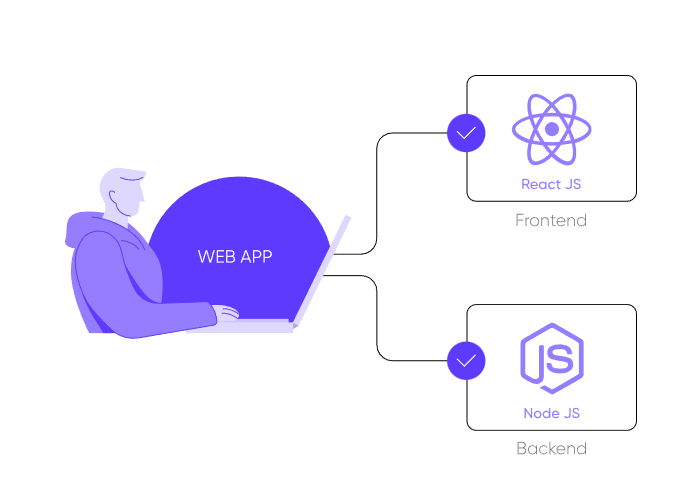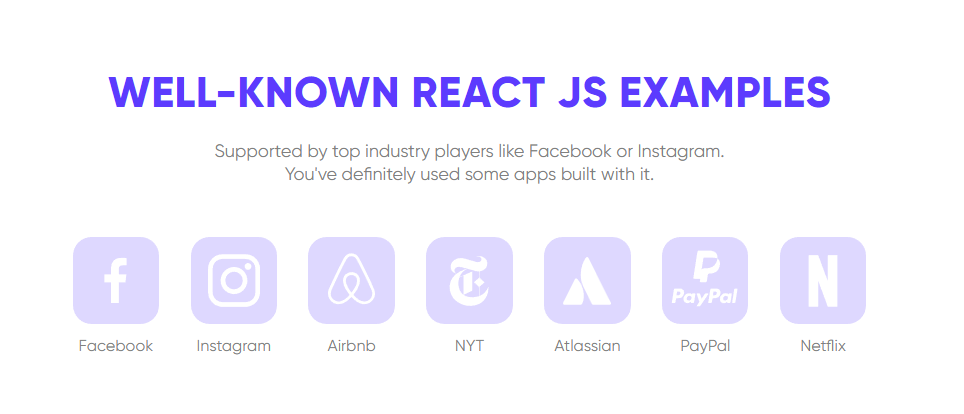Hello, fellow developers and tech enthusiasts!
As we step into 2025, many of you might be pondering a crucial question: Is React JS still a relevant and viable framework in today’s rapidly evolving tech landscape? With the emergence of new technologies and frameworks, it’s natural to question the staying power of React JS.
You might be wondering if it can still meet your development needs, or if it’s time to explore newer alternatives.
Fear not, because we’re here to dive into these pressing concerns. By analyzing current trends, recent updates, and the overall trajectory of React JS, we aim to provide you with a comprehensive understanding of its place in the 2025 tech ecosystem.
In this article, we will identify the benefits of using React JS for web development, including its versatility, scalability, and user-friendly interface. Additionally, we will offer practical advice on how to choose a reputable React JS development agency to ensure your project is in good hands. By the end of this article, you will have a better understanding of whether React JS is the right choice for your business needs.

Also check the list of Top React JS Development Companies.
What is React JS?
React JS is a JavaScript library that is open source and widely used for creating user interfaces (UIs) and single-page applications (SPAs). Originally developed by Facebook in 2011, it has gained popularity for its simplicity, reusability, and high performance. React JS divides the UI into reusable components, each with its own state and properties.
One of the primary benefits of React JS is its ability to update the UI in real-time without the need to reload the entire page. This is made possible by using a virtual DOM, which allows React to quickly and efficiently identify changes that need to be made and update the UI accordingly.
React JS’s ecosystem is another testament to its strength. A rich array of tools and extensions, like Next.js for server-side rendering, which leads to faster initial page load times. Thus NextJS improves search engine optimization (SEO). React JS is also compatible with other libraries and frameworks, such as Redux and React Native, allowing developers to create complex web and mobile applications.
React JS has gained popularity in recent years, with many companies and developers using it as their primary framework for web application development. This is due to its ease of use, extensive feature set, and active community of developers who contribute to its development and maintenance. As a result, React JS is expected to continue growing in popularity and usage in the future.
Also, read Angular vs React Which one to choose?
Current State of React JS: Game-Changer for Modern Businesses
React JS is an excellent choice for web developers who want to build high-performance applications. One of the main advantages of React JS is its speed and lightweight nature. This is made possible by the use of virtual DOM, which enables efficient updating of only the necessary elements on the page, thus saving both time and money.
Another benefit of React JS is its scalability. By dividing the interface into reusable and modifiable components, developers can easily create scalable applications that can adapt to changing requirements.
The development process of React JS is also incredibly user-friendly. Its simple and intuitive syntax makes it easy for even novice developers to learn, and the cost of development is reduced when compared to other libraries.
React JS boasts of a massive community of developers, providing experience sharing, support, and a plethora of tools and libraries to simplify the development process. This vast community makes it easier for developers to get help and resources when needed.
React JS is a flexible framework that can be used on both client and server sides, allowing developers to build applications with greater flexibility.
Finally, there are numerous tools and libraries that simplify working with React JS, such as Redux, React Router, React Native, Material UI, and others, making it even easier for developers to build high-quality applications with React JS.
You may also check the list of Top NextJS Development Companies in USA, UK, India.
What are the Upcoming Trends in Web Development?
The field of web development is known for its rapid evolution, with new technologies and trends emerging constantly. Understanding these trends is crucial for predicting the future trajectory of frameworks like React JS.
1. Mobile-First and Responsive Design
One of the significant trends is the increasing importance of mobile-first and responsive design. As internet usage shifts predominantly towards mobile devices, frameworks that facilitate easy development of mobile-friendly websites are gaining traction. React JS, with its responsive design capabilities and the ability to integrate with React Native for mobile app development, is well-positioned to remain relevant in this mobile-centric era.
2. More Emphasis on Web Performance and User Experience
Another key trend is the growing emphasis on web performance and user experience. Users expect fast, seamless, and engaging web experiences, which puts pressure on developers to optimize performance and load times. React JS’s efficient update and rendering system, utilizing a virtual DOM, is advantageous for creating high-performance web applications.
3. AI & ML in Web Development
The rise of artificial intelligence and machine learning in web development is also noteworthy. These technologies are increasingly being used for personalized user experiences, predictive analytics, and automated content generation. React JS’s flexibility and integration capabilities make it a suitable candidate for projects that harness AI and ML technologies. So ReactJS is going to be the perfect choice among innovators.
4. Serverless Architectures and Microservices
The trend towards serverless architectures and microservices presents new challenges and opportunities. React JS’s compatibility with various backend technologies and its suitability for building scalable applications aligns well with these architectural trends. So you need not worry if you are either a ReactJS developer or building a project on ReactJS.
As we examine these emerging trends, it becomes evident that React JS has the potential to adapt and thrive in 2025 and beyond. However, it’s not without its challenges and competition, which we will discuss in the later section.
What Products Can be Created Using React JS Development?
The ReactJS framework’s prominence is also evident in its widespread adoption by major companies like Airbnb, Netflix, and Instagram, each utilizing ReactJS to enhance user experiences with dynamic and responsive interfaces. For instance, Netflix has credited React JS for significant startup speed improvements and user interface modularity, showcasing the library’s practical benefits in high-traffic environments.
Now let’s look at what we can create using ReactJS.
- Social networks and messaging platforms like Facebook, Instagram, WhatsApp, and Slack can be developed using React JS.
- You can also create online stores and trading platforms, such as Amazon, Etsy, and Shopify, that provide seamless user experience and high-quality performance.
- With React JS, you can design analytics and data management tools like Google Analytics and Trello, that make data management and analysis more efficient.
- Online education applications like Coursera and edX can also be developed with React JS to provide learners with an exceptional online learning experience.
- For entertainment purposes, you can develop games and entertainment applications like Netflix and Hulu.
- React JS is also ideal for developing banking and financial sector applications such as PayPal and Robinhood.
- Tourists can use ticket and tour booking applications like Booking.com and Airbnb, which can also be developed using React JS.
- For the food industry, React JS can be used to create applications for restaurants and food delivery services such as Uber Eats and DoorDash.
These are just a few examples of the unlimited possibilities that React JS Development offers. With your creativity and needs in mind, this library can turn your ideas into innovative and high-performing products.

Challenges in Building Project Using ReactJS
React JS, despite its strong position, faces several challenges and competitors in the dynamic world of web development. Understanding these is key to assessing React JS’s viability in the future.
- One of the main challenges for React JS is keeping up with the rapidly evolving web technologies. Developers increasingly seek frameworks that are not only robust but also flexible enough to integrate with a wide range of other tools and technologies. React JS must continue to evolve, ensuring its ecosystem remains vibrant and its capabilities are aligned with the latest web development needs.
- In terms of competition, frameworks like Vue.js and Angular pose significant challenges. Vue.js, with its simplicity and ease of integration, has been gaining popularity, particularly among smaller projects and startups. Angular, backed by Google, offers a comprehensive solution for enterprise-level applications. Both these frameworks are seen as strong contenders to React JS, offering different philosophies and features that appeal to various segments of developers.
- The rise of new JavaScript frameworks and libraries is another factor. Svelte, for example, introduces a new approach by shifting much of the work to compile time, leading to faster runtime performance. Such innovations continually challenge the dominance of established frameworks like React JS.
Despite these challenges, React JS’s large community, corporate backing, and consistent updates have so far helped it stay ahead in the game. It’s important for React JS to continuously innovate and adapt to maintain its edge.
The future of React JS will be shaped not only by its ability to overcome these challenges but also by how it adapts to the broader trends in web development. In the next section, we’ll dive into predictions and possibilities for React JS in the context of 2025.
Future Predictions for React JS
As we look towards 2025, the future of React JS in the web development arena is a topic of much speculation and anticipation. Based on current trends and expert insights, several predictions can be made about the role and evolution of React JS in the coming years.
1. ReactJS will be the 1st Choice for Single Page Application
React JS is likely to continue its dominance in the SPA (Single Page Application) development space. Its efficient rendering and state management capabilities make it ideal for building dynamic and complex web applications. As businesses continue to prioritize engaging and interactive web experiences, React JS’s strengths in these areas will keep it relevant and in demand.
2. Will be Best for Progressive Web Apps (PWAs)
Another area where React JS could see significant evolution is in its integration with emerging web technologies, like WebAssembly and Progressive Web Apps (PWAs). These technologies aim to enhance web performance and user experience, aligning perfectly with React JS’s core strengths. By embracing these advancements, React JS can offer developers more powerful tools to build cutting-edge web applications.
3. ReactJS Will Provide More Eco-friendly and Accessible Development Options
There’s also a growing focus on sustainability and ethical web development practices. React JS could adapt by providing more eco-friendly and accessible development options, emphasizing efficiency, reduced carbon footprint, and inclusive design.
However, React JS’s future isn’t without uncertainties. The increasing popularity of competitor frameworks and the rapid emergence of new ones will continually challenge its position. React JS will need to innovate, not just in terms of technology but also in community engagement and developer support, to maintain its relevance.
Its journey towards 2025 will be one to watch, as it balances maintaining its core strengths with adapting to new challenges and opportunities.
Also check the list of the best Node.JS Software Development Companies in USA.
Conclusion
In conclusion, it is crucial to note that to achieve successful React JS development, one must consider not only technical aspects but also software engineering practices.
- Firstly, it is imperative to meticulously plan the project, starting with requirements analysis and proceeding to define the scope of work.
- Using development methodologies such as Agile or Scrum is highly recommended for effective project management and increased work efficiency.
- Code quality should be maintained using suitable tools and practices such as Code Reviews and Test-Driven Development.
- Lastly, it is essential to ensure the security of the application, particularly in sensitive cybersecurity areas, by implementing appropriate technologies and methods.
By adhering to these recommendations, you can create a high-quality React JS application while ensuring its long-term efficiency and security.










Leave a Reply